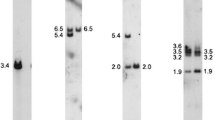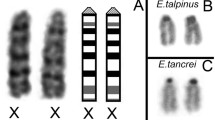Abstract
Common shrews have an XX/XY1Y2 sex chromosome system, with the “X” chromosome being a translocation (tandem fusion) between the “original” X and an autosome; in males this autosome is represented by the Y2 chromosome. From G-banded chromosomes, the Y2 is homologous to the long arm and centromeric part of the short arm of the X. The region of the X that is homologous to the Y2 and also the telomeric region of the short arm of the X were found to be early replicating in somatic cells from a female shrew after 5-bromo-2′-deoxyuridine (BrdU) treatment in vitro. The remainder of the short arm of the X was shown to be late replicating. Electron microscopic examination of synaptonemal complexes in males at pachytene revealed pairing of the Y2 axis with the long arm of the X, and Y1 with the short arm. At early stages of pachytene, there is apparently extensive nonhomologous pairing between the X and Y1. In essence, the short arm of the shrew X chromosome behaves like a typical eutherian X chromosome (it is inactivated in female somatic cells and is paried with the Y1 during male meiosis) while the long arm behaves like an autosome (escapes the inactivation and pairs with the Y2).
Similar content being viewed by others
References
Aniskin VM, Volobouev VT (1980) Chromosomal polymorphism in Siberian populations of the shrews ofaraneus-arcticus complex (Insectivora, Soricidae). I. Chaldeevo and Bericul's populations of the common shrewSorex araneus L. (1758).Genetika 16: 1044–1051 (in Russian)
Ashley T (1985) is crossover between X and Y a regular feature of meiosis in mouse and man? Genetica 66: 161–167
Borodin PM (1991) Synaptonemal complexes of the common shrew,Sorex araneus L., in spermatocyte spreads. Cytogenet Cell Genet 56: 61–62
Burgoyne PS (1982) Genetic homology and crossing over in the X and Y chromosomes of mammals. Hum Genet 61: 85–90
Cattanach BM (1970) Position effect variegation in the mouse. Genet Res 23: 291–306
Disteche CM, Eicher EM, Latt SA (1981) Late replication patterns in adult and embryonic mice carrying Searle's X-autosome translocation. Exp Cell Res 133: 357–362
Eicher EM (1970) X-autosome translocations in the mouse: total inactivation versus partial inactivation of the X-chromosome. Adv Genet 15: 175–259
Elder FFB, Hsu TC (1988) Tandem fusion in the evolution of mammalian chromosomes. In: Daniel A (ed) The cytogenetics of mammalian autosomal rearrangements. Alan R Liss, NY, pp 481–506
Fedyk S, Ivanitskaya EY (1972) Chromosomes of Siberian shrews. Acta Theriol 17: 475–492
Fredga K (1970) Unusual sex chromosome inheritance in mammals. Philos Trans Soc Lond [Biol] 259: 15–36
Galton M, Holt SF (1964) Asynchronous replication of the mouse sex chromosomes. Exp Cell Res 37: 111–116
Graves JAM (1991) Mammalian genome evolution: new clues from comparisons of eutherians, marsupials and monotremes. Comp Biochem Physiol 99A: 5–11
Howell WM, Black DA (1980) Controlled silver-staining of nucleolus organizer-regions with protective colloidal developer: a 1-step method. Experientia 36: 1014–1015
Johannisson R, Gropp A, Winking H, Coerdt W, Rehder H, Schwinger E (1983) Down's syndrome in the male. Reproductive pathology and meiotic studies. Hum Genet 63: 132–138
Kanda N (1973) A new differential technique for staining the heteropycnotic X chromosome in female. Exp Cell Res 80: 463–467
Lyon MF (1968) Chromosomal and subchromosomal inactivation. Annu Rev Genet 2: 31–52
McBurney MW, Strutt BJ (1980) Genetic activity of X-chromosomes in pluripotent female teratocarcinoma cells and their differentiated progeny. Cell 21: 31–52
McBurney MW, Strutt BJ (1980) Genetic activity of X-chromosomes in pluripotent female teratocarcinoma cells and their differentiated progeny. Cell 21: 357–364
Morishima A, Grumbach M, Taylor A (1962) Asynchronous duplication of human chromosomes and the origin of sex chromatin. Proc Natl Acad Sci USA 48: 756–763
O'Brien SJ, Seuanez HN, Womack JE (1988) Mammalian genome organization: an evolutionary view. Annu Rev Genet 22: 332–351
Ohno S (1967) Sex chromosomes and sex-linked genes. Springer, Berlin Heidelberg
Pathak S, Stock AD (1974) The X-chromosome of mammals: karyological homology as revealed by banding techniques. Genetics 78: 703–714
Polani PE (1982) Pairing of X and Y chromosomes, non inactivation of X-linked genes, and the maleness factor. Hum Genet 60: 207–211
Rastan S (1983) Non-random X-chromosome inactivation in mouse X-translocation embryos—location of the inactivation centre. J Embryol Exp Morphol 78: 1–22
Russell LB, Montgomery CS (1970) Comparative studies on X-autosome translocations in the mouse. II. Inactivation of autosomal loci. Segregation and mapping of autosomal breakpoints in five T(X;1)′s. Genetics 64: 281–312
Seabright M (1971) A rapid banding technique for human chromosomes. Lancet II: 971–972
Searle JB (1983) Robertsonian chromosomal variation in the common shrewSorex araneus L. Ph D thesis, University of Aberdeen
Searle JB (1984) Three new karyotypic races of the common shrewSorex araneus (Mammalia: Insectivora) and a phylogeny. Syst Zool 33: 184–194
Searle JB (1986) Meiotic studies of Robertsonian heterozygotes from natural populations of the common shrew,Sorex araneus L. Cytogenet Cell Genet 41: 154–162
Searle JB, Hübner R, Wallace BMN, Garagna S (1990) Robertsonian variation in wild mice and shrews. Chromosomes Today 10: 253–263
Searle JB, Fedyk S, Fredga K, Hausser J, Volobouev VT (1991) Nomenclature for the chromosomes of the common shrew (Sorex araneus). In: Hausser J (ed) The cytogenetics of theSorex araneus group and related topics. Proceedings of the ISACC's Second International Meeting. Mém Soc Vaud Sc Nat 19: 13–22
Sharman GB (1956) Chromosomes of the common shrew. Nature 177: 941–942
Sharman GB (1991) History of discovery and recognition of XY1Y2 systems and chromosome polymorphism in mammals. In: Hausser J (ed) The cytogenetics of theSorex araneus group and related topics. Proceedings of the ISACC's Second International Meeting Mém Soc Vaud Sc Nat 19: 7–12
Solari AJ (1980) Synaptonemal complexes and associated structures in microspread human spermatocytes. Chromosoma 81: 99–112
Tucker PK, Schmidly DJ (1986) Sex chromosome-autosome translocations in the leaf-nose bats, family Phyllostomatidae. Cytogenet Cell Genet 43: 28–37
Volobouev V, Dutrillaux B (1991) Chromosomal evolution and phylogenetic relationships of theSorex araneus-arcticus species group. In: Hausser J (ed) The cytogenetics of theSorex araneus group and related topics. Proceedings of the ISACC's Second International Meeting. Mém Soc Vaud Sc Nat 19: 131–139
Author information
Authors and Affiliations
Additional information
Communicated by: H.C. Macgregor
Rights and permissions
About this article
Cite this article
Pack, S.D., Borodin, P.M., Serov, O.L. et al. The X-autosome translocation in the common shrew (Sorex araneus L.): late replication in female somatic cells and pairing in male meiosis. Chromosoma 102, 355–360 (1993). https://doi.org/10.1007/BF00661279
Received:
Revised:
Accepted:
Issue Date:
DOI: https://doi.org/10.1007/BF00661279




